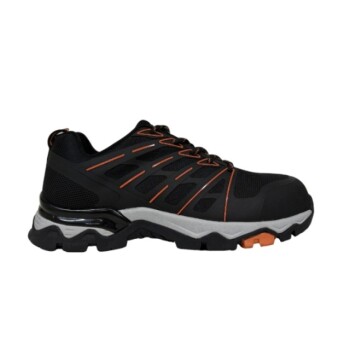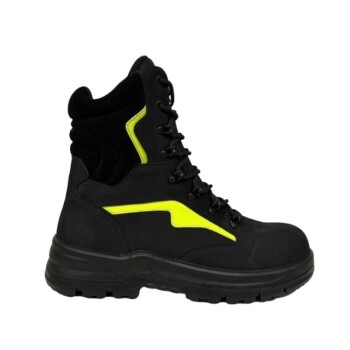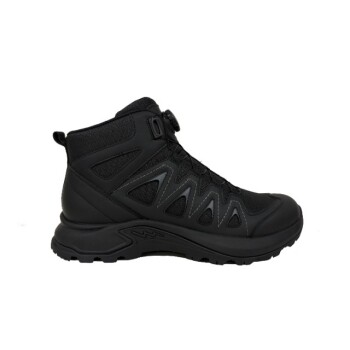To address their environmental impact, safety boot manufacturers are fundamentally rethinking their processes. The core strategies involve shifting to recycled and eco-friendly materials, adopting sustainable leather production methods, implementing comprehensive waste management, and integrating green manufacturing technologies to minimize the overall footprint of production.
The safety footwear industry is moving beyond a linear "take-make-dispose" model by integrating circular economy principles into its supply chain, but this transition requires balancing the non-negotiable demands of safety with the urgent need for sustainability.
The Production Footprint of a Safety Boot
From Raw Material to Final Product
The creation of a safety boot is a multi-stage process, starting with design that must meet strict ergonomic and safety standards.
Materials are then cut and shaped, followed by assembly where components are stitched and bonded together. The final stage involves rigorous quality control to ensure the boot meets all required safety certifications.
The Environmental Cost of Durability
Traditionally, safety boots rely on resource-intensive materials like virgin leather, synthetic rubbers, and plastics.
The tanning process for leather can involve heavy metals and significant water usage, while petroleum-based synthetics contribute to carbon emissions. This creates a direct tension between the need for extreme durability and environmental stewardship.
Key Strategies for Reducing Impact
Innovating with Sustainable Materials
A primary focus is replacing virgin materials with recycled alternatives. This includes using fabrics made from recycled PET bottles for uppers and linings.
Manufacturers are also exploring bio-based polymers and recycled rubber for outsoles, which reduces reliance on fossil fuels and diverts waste from landfills.
Reforming Leather Production
For leather, the industry is moving towards more sustainable sourcing and processing.
This involves sourcing from tanneries that use advanced water treatment and waste reduction systems. The goal is to produce durable, safe leather with a significantly lower chemical and water footprint.
Greening the Factory Floor
Adopting green manufacturing technologies directly targets the assembly phase of production.
This includes using energy-efficient machinery, switching to renewable energy sources, and utilizing advanced bonding adhesives with fewer volatile organic compounds (VOCs). These steps reduce air pollution and greenhouse gas emissions.
Improving Waste Management
A critical strategy is minimizing waste during the cutting and shaping of materials. Advanced pattern-cutting software helps maximize material usage and reduce off-cuts.
Furthermore, manufacturers are developing programs to manage post-consumer waste, exploring ways to deconstruct old boots and recycle their components.
Understanding the Trade-offs
Performance vs. Planet
The absolute priority for a safety boot is worker protection. New, sustainable materials must undergo exhaustive testing to prove they meet or exceed established safety standards for impact, compression, and puncture resistance.
This rigorous validation process can slow the adoption of innovative eco-materials, as safety can never be compromised.
Cost and Scalability
Implementing green technologies and sourcing certified sustainable materials often involves higher upfront costs.
These costs can translate to a higher price point for the end consumer, creating a market challenge when competing against traditionally manufactured, lower-priced boots.
Making an Informed Choice
When evaluating the environmental credentials of a safety boot, your specific priorities will guide your decision.
- If your primary focus is material circularity: Look for boots that explicitly state the use of recycled content, such as recycled PET uppers or recycled rubber in the outsoles.
- If your primary focus is responsible sourcing: Prioritize brands that provide transparency on their leather supply chain and promote sustainable tanning processes.
- If your primary focus is a reduced manufacturing footprint: Seek out companies that publish data on their factory's energy use, water conservation, and waste reduction initiatives.
By understanding these key strategies and their inherent trade-offs, you can better assess which products truly align with your organization's safety and sustainability goals.
Summary Table:
| Strategy | Key Actions | Primary Benefit |
|---|---|---|
| Sustainable Materials | Using recycled PET, bio-polymers, recycled rubber | Reduces virgin resource use and landfill waste |
| Leather Production Reform | Sourcing from tanneries with water treatment and waste reduction | Lowers chemical and water footprint |
| Green Manufacturing | Energy-efficient machinery, renewable energy, low-VOC adhesives | Cuts greenhouse gas emissions and air pollution |
| Waste Management | Advanced pattern-cutting, post-consumer recycling programs | Maximizes material usage and promotes circularity |
Partner with 3515 for Your Sustainable Safety Footwear Needs
As a large-scale manufacturer, 3515 produces a comprehensive range of footwear for distributors, brand owners, and bulk clients. We integrate eco-friendly practices—like using recycled materials and green manufacturing technologies—into our production of all types of safety shoes and boots, ensuring they meet strict safety standards without compromising on sustainability. Let us help you meet your organization's safety and environmental goals with high-quality, responsibly made footwear.
Contact 3515 today to discuss your requirements and explore our sustainable manufacturing capabilities!
Related Products
- Premium Wholesale Waterproof Safety Boots High Performance Protection for Industrial Markets
- Safety Footwear Wholesale Manufacturer for Custom OEM/ODM Production
- Customizable Anti-Smash Safety Boots for Wholesale & Private Label Manufacturing
- Wholesale Slip-On Safety Boots Manufacturer - Custom Puncture-Proof & Steel Toe
- Premium Grain Leather Safety Boots for Bulk Supply
People Also Ask
- What are heavy duty work boots designed for? Maximum Protection for Hazardous Work Environments
- Is there a downside to steel toe boots? Weighing Protection Against Daily Comfort
- Are safety toe options available for women's work boots? A Guide to Steel, Composite & Alloy Toes
- What does the infographic mentioned in the article cover? Prevent Workplace Foot Injuries with the Right Safety Footwear
- What safety standards does the 11-inch waterproof pull-on boot meet? ASTM-Certified Protection for Industrial Work



















